 ... ...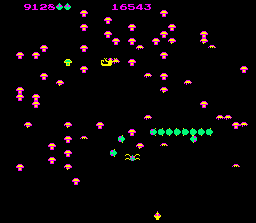
It's difficult for me to look back on my past and come to terms with the fact that several aspects of my hobby have been lost to the winds of time and change. Midway Presents Arcade's Greatest Hits: The Atari Collection 1 replicates six classic arcade games so perfectly that they look, play, and sound exactly like their quarter-munching counterparts. But there were other aesthetics involved in the arcade experience that simply cannot be recaptured in the home.
A major reason to play arcade games was to get the high score. If someone came along and beat your score, you'd pop in another quarter and beat their score. Then someone would beat yours again, and you'd beat theirs, and on and on and on. When playing at home, you can only compete against your own scores, but at what point do you know you've reached your limit? If someone else gets a higher score, then you can get some idea of what you should be capable of. You'd stay motivated. Another part of the fun was having an audience, as sometimes interested parties would watch over your shoulder. With home versions, all of that's missing.
And yet the oldschool gamer in me sometimes can't help itself. No matter what they may lose in the transition from arcade to home, I still occasionally revisit these games. They're an important part of both video game history and my own. They're what created the standards and provided outlines for generations of games to come. They're what originally caught my attention in those smoky old arcade rooms - the first steps in defining video games as the art form I'd become most involved with.
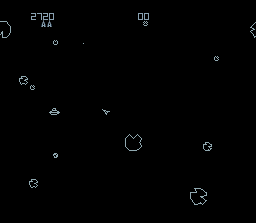 ... ... ASTEROIDS
ASTEROIDS
Asteroids is my favorite of the games on this collection, and it was one of the earliest video games that was a smash hit (even getting mentioned in the Steven Spielberg movie, E.T., long before such references in pop culture became commonplace). For a game created when the industry was still in an experimental stage, it's amazing how well certain aspects of it work. The first is the play control, which uses a "turn-and-thrust" mechanism. A little practice may be required to sufficiently acclimate to it, but it's otherwise very intuitive.
The second is that the game becomes quite hectic after a few rounds, literally filling the screen with asteroid chunks and UFO bullets. When considering the many later shooters that you can practically play through with your eyes closed, Asteroids is a reminder of how intense gaming can and should be.
Although Asteroids had been successfully reproduced on the Atari 7800 before, this version mimics the eerie vector-line graphics of the original arcade game, as opposed to having colorful asteroid blobs. And there are no terrible 7800 controllers to hamper progress as the game plays quite nicely with the Super NES controller's D-Pad.
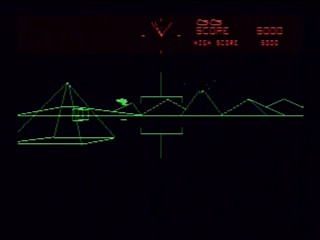 ... ...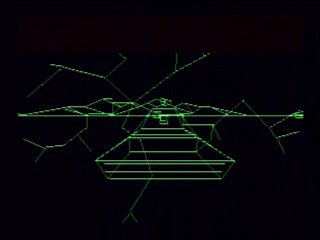 BATTLE ZONE
BATTLE ZONE
Battle Zone is a game that remains a mystery to me. I wouldn't doubt that part of the problem stems from never having played it in an arcade. It was one of the first "3D" games (using vector-lines to achieve that illusion). It was apparently so impressive in its day that the US military approached Atari about creating a combat training simulator, a fact I find so mind-blowing, I don't know what to make of it. Of course, I've never driven a tank, so I can't really comment on how realistic Battle Zone's interpretation of what it's like is. Yet somehow, I remain skeptical.
The tank's controls are meant to be realistic, which means they're sluggish and unintuitive. It's tough to take out enemies without it turning into a 3D version of the infamous Atari 2600 Combat stand-off in which you plod towards each other, firing your cannons, and whoever gets hit first loses. I'm aware of tricks that allow you to survive and actually get somewhere, but I find it hard to stay motivated long enough to master them.
Battle Zone is worth playing a few times to see the graphics (the erupting volcano in the background being my favorite special effect), and to experience a little of gaming history, but I imagine only those with memories of playing the arcade version will regard it as more than a curious novelty.
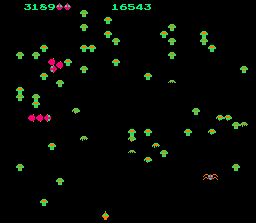 ... ...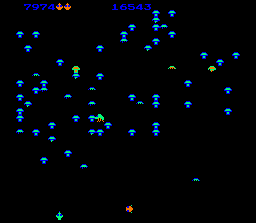 CENTIPEDE
CENTIPEDE
Centipede is like a more complex version of Space Invaders. Giant arachnids and insects descend from the top of the screen and you shoot them with a cannon. The catch is that each time you shoot one of the Centipede's body segments it turns into a mushroom. Bumping into mushrooms causes the Centipede to drop down a line. Eventually the entire playing field becomes so overloaded with mushrooms that the Centipede divebombs to the bottom of the screen within seconds of the round's start, at which point all hell breaks loose. This is what inspired my strategy of trying to destroy every mushroom in the first few rounds.
As a simple shooter, Centipede can be fun for awhile, and it's one of the easier games to get into on this collection. Like all games of this era, there's no end to it, so after a few plays, you'll probably want to move on. It is interesting to note that this might be the first example of getting to play as the "bad guy" in a game. What did those bugs ever do to you, after all?
 ... ...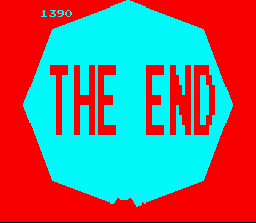 MISSILE COMMAND
MISSILE COMMAND
What's interesting about early arcade games is their not-so-subliminally negative perspective. Think about it, there are no "happy endings". No matter how much it tries, the spaceship in Asteroids will always be destroyed. No matter how many times Mario rescues Pauline, Donkey Kong will snatch her away again. And poor ol' Pac-Man is eternally trapped in a maze where he's doomed to be consumed by the ghosts. Perhaps no game was more nihilistic than Missile Command. The only possible outcome is total nuclear devastation of all life on Earth. It's profoundly underlined by one of the most unsettling "Game Over" screens in history: A billowing explosion culminates with giant block letters spelling out "THE END". That the image looks so obviously like something that came from a computer, as opposed to being drawn by human hands, the message seems all the more cold and unforgiving.
But before we even get to that scene, Missile Command offers hectic gameplay that becomes almost impossible to keep up with after only a few rounds. As nuclear warheads rain down from the heavens, you must use three ground-based missile silos and a single crosshairs to intercept them and protect your cities. Eventually, strategizing and planning go right out the window as any attempts to do either will prove futile. I'm sure many players will recall rolling the trackball controller as fast as they could and firing all over the screen. I'm sure even more will remember that the only strategy of any kind that works to some degree is to concentrate on protecting just one city.
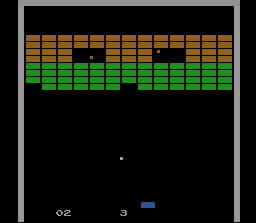 ... ...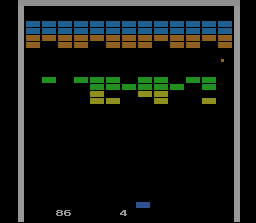 SUPER BREAKOUT
SUPER BREAKOUT
Super Breakout is the most primitive of the games on this collection, both in graphics, sound effects, and game design (almost pathetically so). It involves using a paddle to bounce a ball into a brick wall in what is basically a one-player version of Pong.
There are three variations that differentiate Super Breakout from its predecessor Breakout: "Cavity" has two extra balls trapped within the wall. "Progressive" causes multiple walls to drop down every so often. "Double" is just like the original Breakout except that you get two paddles, one right above the other. I find it easiest to rack up high scores on the "Progressive" setting. If you can get the ball between two of the walls, you'll accumulate over 300 points in no time. Super Breakout is mildly amusing on that setting, but still mind-numbing in its simplicity.
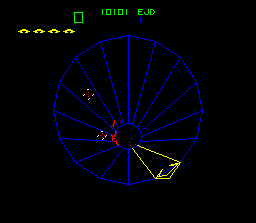 ... ... TEMPEST
TEMPEST
Tempest is the only other game on this collection besides Battle Zone that I had no prior experience with. It is probably for that reason that the game is somewhat of a mystery to me. It is very similar in style to Konami's arcade classic Gyruss, but instead of having free 360 degree movement around the screen, the "Zapper" you control is only capable of flipping itself around the perimeter of a predetermined "funnel" shape composed of vector lines. Compared to Gyruss, the movement is choppy, and the control isn't anywhere near as fast and fluid.
Even more disconcerting is that the game's rules are very unclear and seem arbitrary. Enemies come up from the bottom of the funnel and those you fail to obliterate will reach the top and proceed in your direction. Sometimes you can destroy them or flip right through them, but other times they kill you instantly if you try. The problem is that I don't know why flipping through them sometimes results in your demise and sometimes theirs.
Tempest certainly looks neat, especially the scaling effect of warping to the next stage, and it has some good sound effects. But as someone who does not have nostalgic memories of playing it in the arcades, I can't honestly say it has stood the test of time as well as Gyruss (which I also had no prior experience with before its release on Konami Arcade Classics).
The strength of Arcade's Greatest Hits lies in it being a collection. As amusing, fun, or historically important as most of the games are, it is hard to imagine buying them as stand-alones anymore. It is certainly nice that the technology of the 16-bit era was finally able to bring these classics home in their original unaltered forms, yet I can't help but feel that progress had missed the boat. By the time this cartridge went on sale, there was no arcade nearby to play Asteroids, Centipede, or Missile Command, and they disappeared before I ever had a chance to become acquainted with Tempest or Battle Zone. Hopes of practicing these games at home to get higher scores on the real arcade machines were now but a pipe dream.
While technology was busy catching up to itself, many aspects of my life had changed, video games had changed, and the desire to have those old quarter-munchers at home all but waned away. None of this, of course, is the fault of the collection itself, as it is presented very nicely and does exactly what is expected of it. I just wish that it could serve as something more than a reminder, but it's hard to maintain prolonged interest in it for any other reason.
Score: 3.5/5
|